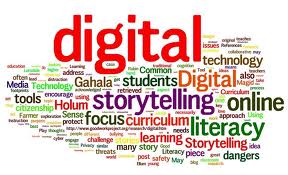This session’s focus was on what it means for children to be digitally literate. From an early group discussion, it was clear that the term ‘digital literacy’ is contested and is understood in different ways by people. The definition provided by Futurelab , 2010 introduces the term effectively: “digital literacy is the way in which people, understand, make and share meaning with digital media and technologies”.
I found myself reflecting on my use of digital technology in my education and in my life in general and it is amazing to see how things have evolved since I was at school. There is no doubt that we are living in a digital culture- where people are increasingly shopping on-line, students are researching projects on the internet and where people are communicating with friends and family through social media sites. Considering this, it is crucial that children have ample opportunity to familiarise themselves with these technologies and build their confidence to explore the use of a range of technologies so they are able to adapt and thrive in this digital age.
The ‘8 Essential Elements of Digital Literacies’ (Cultural, Cognitive,Constructive, Communicative,Confident,Creative, Critical,Civic) were introduced as we watched a video by Doug Belshaw. Views to reflect upon from the video include (a) not ranking the elements in importance as it depends on the child (b) being wary of one definition of digital literacy and (c) the need to consider context-age/geographical location/stage of development, in determining what digital technologies a child should be aware of.
The task of presenting a modern day interpretation of a fairytale using the ‘Puppet Pals’ app was an excellent way to see elements of these digital literacies in action. Reflecting on this task, I feel that it demonstrates how digital technology can be utilised to providing an engaging platform for children to be creative and work collaboratively by sharing ideas and skills and introduce them to ICT skills (collating material using the internet) .
AlthoughI firmly believe that children should have the opportunity to explore a wide range of digital technologies, there are things to consider. The issues involved with safeguarding and wellbeing and e-safety have been previously discussed in our earlier blog posts and these issues cannot be ignored. I have seen how my placement school aim to increase parents’ awareness of the potential dangers that are posed with on-line technology and I strongly believe that this should be incorporated within every schools policy.
Reflecting on this session, our explorations of a variety of digital technologies through this module and my observations on the use of ICT during my school based training has provided food for thought in my continuing professional development. One of my aims for my upcoming placements is to continue developing my own skills and confidence in the use of digital technologies so that I am able to facilitate effective learning and development of digital literacy in and outside of the classroom.
Grant,L. (2010) Connecting digital literacy between home and school [online],Futurelab
Available:http://www.futurelab.org.uk/sites/default/files/Connecting_digital_literacy_between_home_and_school.pdf [Accessed 25/11/2013)

Really good points James. I particularly liked your statement
“It is crucial that children have ample opportunity to familiarise themselves with these technologies and build their confidence to explore the use of a range of technologies so they are able to adapt and thrive in this digital age.”
This really made me think about teachers in general. Are all teachers digitally literate enough for this to be the case? I don’t think so, I believe to make the next generation digitally literate (and safe users of technology) there needs to be more enthuses of helping current teachers become confident with technology themselves. I feel that this module has supported my digital literacy and I do feel more confident with the new curriculum.
The 8 parts of digital literacy, I feel, is a little bit wishy washy. To my mind it doesn’t really help to further understanding of digital literacy. James I think your points our really good on digital literacy.
I thoroughly agree with the thoughts of this blog post. I found it very interesting that, within the discussion of only our small group, there was such a wide range of ideas and opinions of what the term ‘digital literacy’ meant. This really did bring my attention to how teacher’s differing understanding of this term may greatly effect how they plan to use different technologies in their classroom and to what extent they intend to include these. How can we be sure that children are all receiving enough support with a range of technologies to ensure they are equipped for the wider world and, as Adam said, have the necessary understanding to be safe online, if teacher’s themselves are not confident and knowledgeable with these?
I also find it extremely important to emphasise the point made that the 8 elements of digital literacy will vary in importance in relation to the specific child, and that in any instance the needs of the individual is what comes first, thus determining this order.
I am confident in saying discussions such as these, together with my on-going development of understanding with different technologies, will increase the level of thought I will give to the ways I can incorporate current technology in my classroom, to support the children’s learning and prepare them for later life.